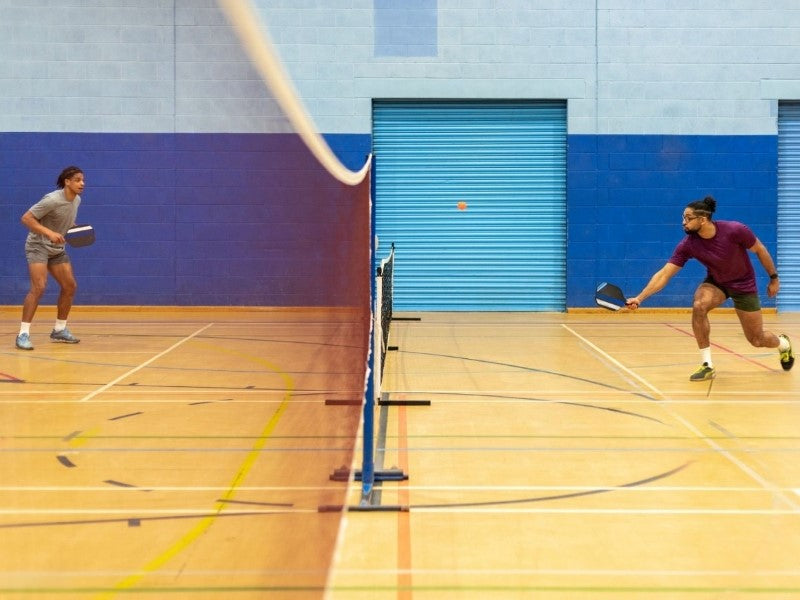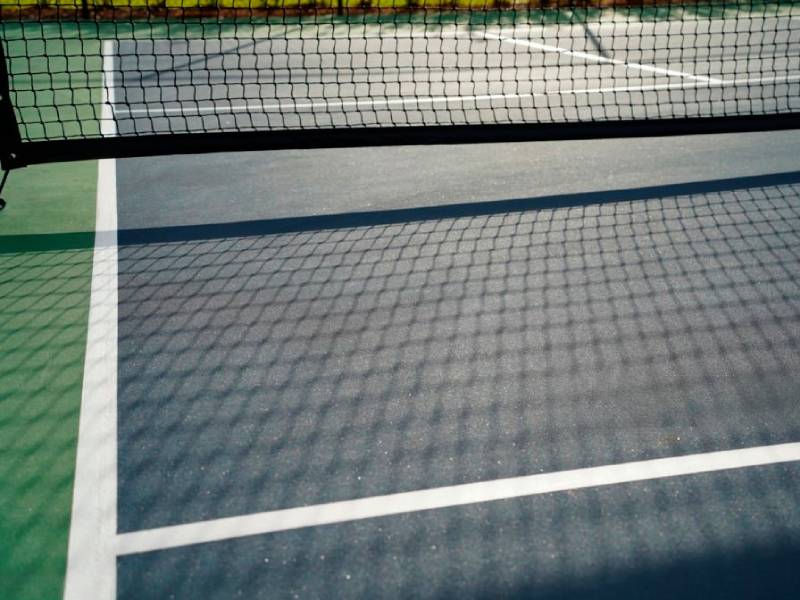Pickleball is rapidly becoming one of the most popular sports worldwide, enjoyed by players of all ages and skill levels. Whether you're setting up a court in your backyard, a community center, or a professional venue, understanding the correct pickleball net size is crucial. The net size directly impacts the pace, fairness, and overall enjoyment of the game.
Choosing the right net—whether a regulation net for official play or a portable net for casual games—ensures a consistent playing experience.
Understanding Official Pickleball Net Size Regulations
The official pickleball net size is defined by organizations like the USA Pickleball Association (USAPA) and the International Federation of Pickleball (IFP). According to their regulations:
- The net must be 22 feet (6.7 meters) wide to cover the full court width.
- The net height should be 36 inches (91.44 cm) at the sidelines.
- The net height at the center should be 34 inches (86.36 cm).
This 2-inch difference between the sidelines and center creates a slight dip, similar to tennis nets, which helps maintain proper tension and fair play.
The reason for this dip is to prevent sagging in the middle, which could otherwise alter the ball’s trajectory and give an unfair advantage. Proper net height is critical for gameplay, influencing serves, volleys, and rallies.

Characteristics of Regulation Pickleball Nets
Regulation nets are designed specifically for competitive play and usually feature:
- Durable mesh fabric, often weather-resistant for outdoor use.
- A strong steel or aluminum tension cable running through the top edge to maintain tautness.
- A center strap that holds the net at 34 inches in the middle.
- Sturdy posts installed either permanently or semi-permanently to hold the net.
These nets are built for longevity and consistent performance in tournament settings. They must comply strictly with size and tension standards to ensure fairness and uniformity.
Overview of Portable Pickleball Nets
Portable nets offer convenience and flexibility, popular among recreational players, beginners, and those without access to a permanent court.
Common features include:
- Lightweight frames made from materials like fiberglass or lightweight aluminum.
- Foldable or telescoping poles and a compact carrying case for easy transport.
- Adjustable heights that can be set close to regulation but often vary slightly.
- Sizes that range typically from 18 to 22 feet wide, sometimes shorter for easier portability.
Though portable nets are user-friendly and affordable, they may not always meet strict official standards, especially in terms of tension and exact height.
Size Differences: Regulation Nets vs Portable Nets
The main differences in size between regulation and portable nets include:
|
Feature |
Regulation Net |
Portable Net |
|
Width |
Exactly 22 feet (6.7 meters) |
Usually between 18–22 feet |
|
Height at Sidelines |
36 inches (91.44 cm) |
Varies, often adjustable but less precise |
|
Height at Center |
34 inches (86.36 cm) |
Sometimes uniform height or adjustable dip |
|
Tension System |
High-quality steel/aluminum cable |
Basic tension cables or elastic cords |
These differences affect how the net performs during play. Regulation nets maintain consistent tension and height, while portable nets prioritize ease of setup, sometimes at the expense of exact measurements.
Pros and Cons: Regulation Nets vs Portable Nets
Regulation Pickleball Nets – Pros
- Maximum Stability: Built with heavy-duty steel posts and strong netting, regulation nets stay firmly in place, even in windy conditions or during aggressive play.
- Professional Play Experience: Because they meet USA Pickleball Association (USAPA) standards in both size and tension, you get a true “tournament feel” every time you play.
- Durability for Outdoor Use: Weather-resistant coatings and premium materials mean they can handle months — even years — of exposure to sun, rain, and temperature changes without sagging or fraying.
- Low Maintenance: Once installed and tensioned properly, they require very little adjustment over time.
Regulation Pickleball Nets – Cons
- Not Portable: Due to their heavy and fixed structure, they’re not designed to be moved frequently.
- Higher Upfront Cost: Quality materials and permanent installation make them more expensive initially.
- Space Requirement: You’ll need a dedicated court space; they’re not suitable for casual backyard setups.
Portable Pickleball Nets – Pros
- Easy to Move and Store: Lightweight frames, often under 30 pounds, make them simple to transport in a car or store in a closet or garage.
- Quick Setup: Most can be assembled in under 10 minutes without tools, perfect for casual games or temporary courts.
- Affordable Entry Point: Great for beginners, community groups, or schools that don’t want to commit to permanent installations.
- Flexible Location Use: Ideal for driveways, gym floors, parks, or temporary tournament setups.
Portable Pickleball Nets – Cons
- Less Stable in Wind: Lightweight frames can shift or lean during strong gusts, especially on uneven surfaces.
- Requires Regular Adjustment: The net tension may loosen over time, so you might need to re-tighten straps or cords during play.
- Shorter Lifespan: While still durable, portable nets typically use lighter materials that may wear faster with heavy, daily outdoor use.
Quick Takeaway:
If you value professional play quality and long-term durability, a regulation net is worth the investment — especially for clubs, dedicated courts, or serious players. If flexibility, portability, and lower cost are more important, a portable net is your best choice.
Material Differences Between Regulation and Portable Pickleball Nets
Regulation pickleball nets — the kind you’ll see on permanent courts — are usually made with strong steel posts that are coated to prevent rust, plus a thick vinyl headband along the top to protect the net from wear. The net itself is often braided nylon or polyethylene, which is designed to handle outdoor sun and rain without breaking down. Because the frame is heavy and solid, these nets hold their shape and tension for a long time, even with daily use.
Portable pickleball nets, on the other hand, focus on being light and easy to move. Their frames are often made from lightweight aluminum or coated metal tubing, which makes them easy to carry and set up. The netting is still durable but usually a bit thinner than in regulation nets. Instead of a thick steel cable for tension, portable nets often use bungee cords or straps, which are quick to adjust but may need tightening during play. In short, regulation nets are built for stability and long-term outdoor use, while portable nets trade some of that durability for convenience and portability.
How to Choose the Right Net Size for Your Needs
When selecting a pickleball net, consider the following factors:
- Usage Scenario: Backyard fun, community clubs, or official competitions
- Budget: Regulation nets are costlier; portable nets offer a budget-friendly alternative
- Space Available: Fixed courts suit regulation nets, while portable nets suit temporary setups
- Portability Needs: Frequent moves favor lightweight, portable options
- Maintenance Capability: Regulation nets require regular upkeep; portable nets are generally low-maintenance
Evaluating these points will help you find the net that best fits your needs.

Installation Tips for Regulation and Portable Nets
- Ensure a Level Surface: Uneven ground affects net height and tension
- Measure Net Height Accurately: Use a tape measure to confirm 36 inches at sidelines and 34 inches at the center
- Adjust Tension Properly: Tighten the top cable to avoid sagging in the middle
- Secure the Center Strap: Keeps the net height consistent at the middle
- Quick Setup for Portable Nets: Use provided clips, telescoping poles, and carry cases for efficient installation
Proper installation guarantees fair play and enhances your overall game experience.
Maintenance and Longevity of Different Net Types
- Regulation Nets: Regularly inspect tension cables, clean mesh fabric, protect from prolonged UV exposure, and dry thoroughly after rain
- Portable Nets: Store in dry bags after use, avoid sharp bends, check clips and poles periodically
- Replace worn parts as needed to prolong net life
Common Myths and Misconceptions About Pickleball Net Sizes
“Portable nets don’t meet standards, so they ruin gameplay.”
Official tournaments require standard nets; portable nets are perfect for casual play.
“Minor net height differences don’t matter.”
Even slight deviations can impact serve and shot consistency.
“All nets can be easily adjusted.”
Some portable nets have limited adjustability and can’t always meet official specs.
Understanding these points helps set realistic expectations.
By understanding the differences in size, materials, and installation requirements, and by considering your own needs and budget, you can make an informed decision. The correct net size and proper installation not only ensure fair and competitive gameplay but also enhance every serve, volley, and rally.
Ready to elevate your game? Pick the right pickleball net and start enjoying this fast-growing sport to the fullest!









Leave a comment
This site is protected by hCaptcha and the hCaptcha Privacy Policy and Terms of Service apply.